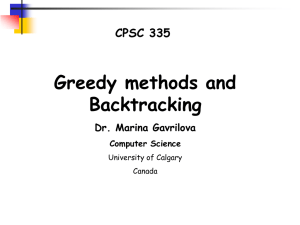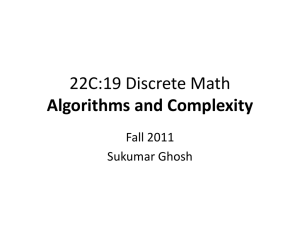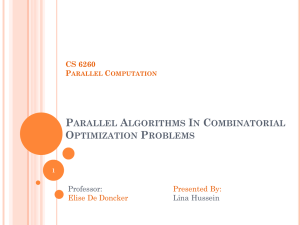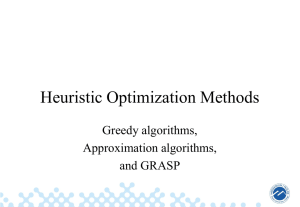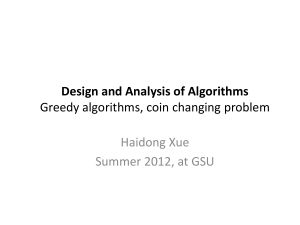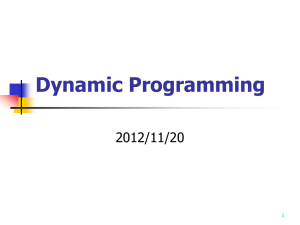Greedy - It works!
advertisement
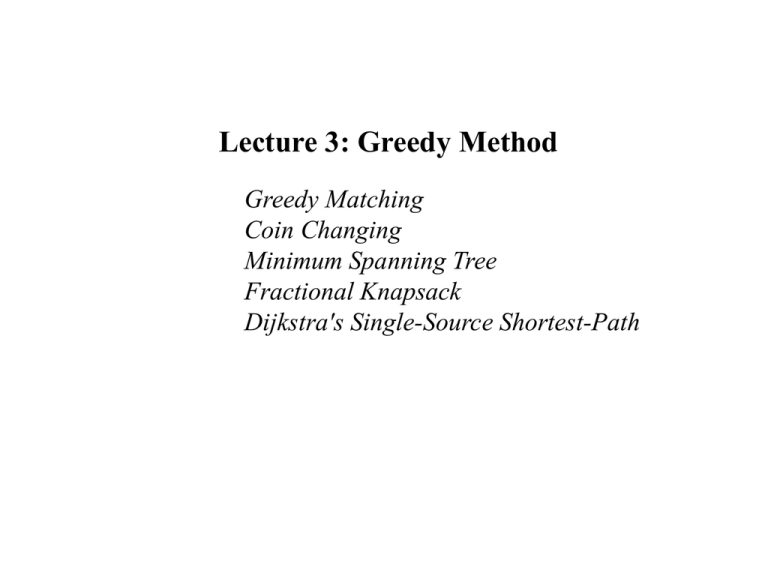
Lecture 3: Greedy Method
Greedy Matching
Coin Changing
Minimum Spanning Tree
Fractional Knapsack
Dijkstra's Single-Source Shortest-Path
Greedy Method
The Greedy Concept
Makes the choice that looks best at the moment.
Hopes that ''local optimal'' choices lead to ''global optimal'. solution.
Two basic properties of optimal greedy algorithms
Optimal Substructure Property: A problem has optimal substructure if an
optimal solution to the problem contains within it optimal solutions to its
sub problems.
Greedy Choice Property: If a local greedy choice is made, then an optimal
solution including this choice is possible.
Advanced Algorithms, Feodor F. Dragan, Kent State University
Greedy Matching
M={ }
V={ABCDEFGH}
E = {(AB),(AD),(AE),(BC),(BE),(CE),(CF),
(DE),(DG),(DH),(EF),(EH),(FH),(GH)}
A
B
D
C
F
E
G
H
The Annals of Applied Probability, Vol. 3, No. 2. (May, 1993), pp. 526-552
Greedy Matching
M = {(CE)}
V={ABCDEFGH}
E = {(AB),(AD),(AE),(BC),(BE),(CE),(CF),
(DE),(DG),(DH),(EF),(EH),(FH),(GH)}
A
B
D
C
F
E
G
H
Greedy Matching
M = {(CE)}
V={ABCDEFGH}
E = {(AB),(AD),(AE),(BC),(BE),(CE),(CF),
(DE),(DG),(DH),(EF),(EH),(FH),(GH)}
A
B
D
C
F
E
G
H
Greedy Matching
M = {(CE),(AB)}
V={ABCDEFGH}
E = {(AB),(AD),(AE),(BC),(BE),(CE),(CF),
(DE),(DG),(DH),(EF),(EH),(FH),(GH)}
A
B
D
C
F
E
G
H
Greedy Matching
M = {(CE),(AB)}
V={ABCDEFGH}
E = {(AB),(AD),(AE),(BC),(BE),(CE),(CF),
(DE),(DG),(DH),(EF),(EH),(FH),(GH)}
A
B
D
C
F
E
G
H
Greedy Matching
M = {(CE),(AB),(GH)}
V={ABCDEFGH}
E = {(AB),(AD),(AE),(BC),(BE),(CE),(CF),
(DE),(DG),(DH),(EF),(EH),(FH),(GH)}
A
B
D
C
F
E
G
H
Greedy Matching
M = {(CE),(AB),(GH)}
V={ABCDEFGH}
E = {(AB),(AD),(AE),(BC),(BE),(CE),(CF),
(DE),(DG),(DH),(EF),(EH),(FH),(GH)}
A
B
D
C
F
E
G
H
Coin Changing
An optimal solution to the coin changing problem is the minimum number of
coins whose total value equals a specified amount. For example what is the
minimum number of coins (current U.S. mint) needed to total 83 cents.
83 - 25 = 58
58 - 25 = 33
33 - 25 =
8
8 -
5 =
3
3 -
1 =
2
2 -
1 =
1
1 -
1 =
0
A Greedy Algorithm for
Coin Changing
1. Set remval=initial_value
2. Choose largest coin that
is less than remval.
3. Add coin to set of coins
and set
remval:=revamal-coin_value
4. repeat Steps 2 and 3
until remval = 0;
Coin Changing - Another Example
The greedy method works for the U.S. minted coin set, but will it work for
any coin set? Consider the coin set below and a change value of 82 cents..
82 - 26 = 56
56 - 26 = 30
30 - 26 =
4
4 -
1 =
3
3 -
1 =
2
2 -
1 =
1
1 -
1 =
0
By the coin-changing algorithm we obtain 3 26 cent pieces and 4
pennies, but we can use 2 26 cent pieces and 3 dimes to total 82
cents. Hence the greedy approach does not work for this coin set.
When Does the Greedy Method Work?
When using the U.S. minted coin set, we find that the coin-changing algorithm
gives us the minimum number of coins. However, this greedy algorithm does not
work when we replace the quarter with a 26-cent piece.
See if you can determine the necessary relationships between coin values in a
coin set for which the greedy coin-changing algorithm will result in a minimum
number of coins for any initial_value.
For your rules to be correct they must hold up under the following evaluations:
1. See if you can find a coin set that follows the rules but doesn't support the
greedy algorithm.
2. Alternately you can attempt to find a coin set that supports the greedy
algorithm but is not represented by the rules.
Prim's Algorithm
Given a weighted graph G consisting of a set of vertices V and a set of
edges E with weights, where e ( v i , v j ) E and v i , v j V Prepare a vertex set
and an edge set to hold elements selected by Prim's Algorithm.
1. Choose an arbitrary starting vertex vj
2. Find the smallest edge e incident with
with a vertex in the vertex set whose
inclusion in the edge set does not create a
cycle.
3. Include this edge in the edge list and its
vertices in the vertex list.
4. Repeat Steps 2 and 3 until all vertices are
in the vertex list.
1
B
A
2
2
5
C
2
D
E
1
1
4
3
1
2
G
F
Exercise Prim's Algorithm on this example weighted graph starting with vertex
B and again starting at vertex F. Did you get the same spanning tree? If the
trees were distinct, did they have the same value?
2
Kruskal's Algorithm
The minimum spanning tree problem can also be solved using Kruskal's Algorithm.
In this approach, we simply choose minimum-weight edges from the graph so long as
an edge does not create a cycle in the edge set. We stop choosing edges when every
vertex is a node for at least one of the edges in the set and the tree is connected.
B
1
A
2
2
D
4
1
3
E
E
2
5
3
4
G
F
2
2
E
1 C
2
1
3
4
G
2
2
F
2
B
1 C
2
5
2
D
1
E
2
G
1
2
F
3
A
D
1
4
1
1
2
2
E
2
B
5
2
D
2
A
2
D
1
F
1 C
2
5
2
G
1
1 C
1
E
3
1
A
4
1
B
1
2
D
2
F
2
2
G
1
A
1 C
2
5
2
B
1
A
1 C
2
5
B
1
3
4
G
1
F
2
2
Knapsack Problem
A thief can carry a maximum weight in his knapsack and he wants to maximize
the amount of value he carries. There is a given amount of each type of item
and each item has a specified total value. How much of each item should he
carry to get the maximum value? Maximum weight = 75.
Item #
Total
Weight
Total
Value
V/W Order
Taken
Fract
Taken
1
20
10
1/2
4
0.0
2
40
25
5/8
2
1.0
3
10
15
3/2
1
1.0
4
50
30
3/5
3
0.5
5
30
10
1/3
5
0.0
Total
Weight
Total
Value
75
55
If we compute the ratio of the total value to the total weight, we can arrange the
items in the order of preference. Then we can take the most valuable items first.
Eventually we will fill our knapsack by taking as much of the last item as will fit.
0/1 Knapsack Problem
We now consider the case in which fractional portions of an item are not allowed.
That is the thief must take all or none of each item.
Item #
Total
Weight
Total
Value
V/W
Rank
Order
Item
Value
1
20
10
1/2
4
10
2
40
25
5/8
2
25
3
10
15
3/2
1
15
4
50
30
3/5
3
X
5
30
10
1/3
5
Total
Weight
Total
Value
70
50
This is called the 0/1 knapsack problem. As shown in this example, the greedy
method does not apply to this problem. The third most valuable item is too heavy
to be added to the knapsack. Develop an example 0/1 knapsack problem in
which the most valuable item is not an item in the optimal solution. (Weight of
most valuable item cannot exceed weight limit by itself.)
Single Source Shortest Path
Given a weighted graph G find the minimum weight path from a specified vertex v0 to every other
vertex.
2
v1
v2
5
1
v0
3
v3
4
1
v4
1
6
v5
1
3
The single source shortest path problem is as follows. We are given a directed graph with
nonnegative edge weights G = (V,E) and a distinguished source vertex, s V . The problem is to
determine the distance from the source vertex to every vertex in the graph.
Dijkstra's Algorithm for SSSP
v1
v2
v3
v4
v5
5
1
4
-
6
{2}
node
3
minimum
4
2
6
{24}
list
3
path
3
5
3
5
{241}
{2413}
4
2
v1
v2
5
1
v0
3
v3
4
1
v4
1
6
v5
1
3
Summary
Greedy Matching
Coin Changing
Greedy Optimal
Greedy Non-Optimal
Minimum Spanning Tree
Prim's Algorithm
Kruskal's Algorithm
Knapsack
Fractional Knapsack
0/1 Knapsack
Diskstra's Single-Source Shortest Path Algorithm

